Binomial distribution
The binomial distribution is one of the most important discrete probability distributions.
It describes the number of successes in a series of similar and independent experiments, each of which has exactly two possible outcomes ("success" or "failure"). Such series of experiments are also called Bernoulli processes.
If 






The binomial distribution and the Bernoulli test can be illustrated with the help of the Galton board. This is a mechanical apparatus into which balls are thrown. These then fall randomly into one of several compartments, where the distribution corresponds to the binomial distribution. Depending on the construction, different parameters 

Although the binomial distribution was known long before, the term was first used in 1911 in a book by George Udny Yule.
Binomial distributions for
with 

The probability that a ball in a Galton board with eight levels ( 


Examples
The probability of rolling a number greater than 2 with a normal die is 






The process described by the binomial distribution is often illustrated by a so-called urn model. In an urn, for example, there are 6 balls, 2 of them black, the others white. Reach into the urn 10 times, take out one ball, note its color and put the ball back. In a special interpretation of this process, drawing a white ball is understood as a "positive event" with probability 
Definition
Probability function, (cumulative) distribution function, properties
The discrete probability distribution with the probability function
is called the binomial distribution for the parameters 
![{\displaystyle p\in \left[0,1\right]}](https://www.alegsaonline.com/image/403c14a696bad2adffdf3b4b91494c89fb043180.svg)
Note: This formula uses the convention 
The above formula can be understood like this: We need for a total of 











The failure probability 

As necessary for a probability distribution, the probabilities for all possible values 
A random variable 




where ⌊ 
Other common notations of the cumulative binomial distribution are 


Derivation as Laplace probability
Experiment scheme: An urn contains 





We calculate the number of possibilities in which 
For each of the 











Cases where exactly 



Properties
Symmetry
- The binomial distribution is symmetric in the special cases
,
and
symmetric and otherwise asymmetric.
- The binomial distribution has the property
Expected value
The binomial distribution has the expected value 
Proof
The expected value μ 

Alternatively, use that a 




Alternatively, one can also give the following proof using the binomial theorem: If one differentiates at the equation
both sides to 

so

With 
Variance
The binomial distribution has variance 

Proof



or, alternatively, from Bienaymé's equation applied to the variance of independent random variables, considering that the identical individual processes 
The second equality holds because the individual experiments are independent, so the individual variables are uncorrelated.
Coefficient of variation
From the expected value and variance one obtains the coefficient of variation
Skew
The skewness results to
Camber
The curvature can also be represented closed as
Thus the excess
Mode
The mode, i.e. the value with the maximum probability, is for 




Proof
Let be without restriction We consider the quotient

Now α 


And only in the case the quotient 

Median
It is not possible to give a general formula for the median of the binomial distribution. Therefore, different cases have to be considered which provide a suitable median:
- If is
a natural number, then the expected value, median, and mode agree and are equal to
.
- A median
lies in the interval ⌊
. Here, ⌊ denote
the rounding function and ⌈
denote the rounding up function.
- A median
cannot deviate too much from the expected value:
.
- The median is unique and coincides with
round
if either
or
or
(except when
and is
even).
- If
and is
odd, then every number
in the interval
a median of the binomial distribution with parameters
and
. If
and
is even, then
the unique median.
Cumulants
Analogous to the Bernoulli distribution, the cumulant generating function is

Thus, the first cumulants κ 
Characteristic function
The characteristic function has the form
Probability generating function
For the probability generating function we get
Moment generating function
The moment generating function of the binomial distribution is
Sum of binomial distributed random variables
For the sum 






thus again a binomially distributed random variable, but with the parameters 

Thus, the binomial distribution is reproductive for fixed 
If the sum 


This represents a hypergeometric distribution.
In general: If the 







Relationship to other distributions
Relationship to Bernoulli distribution
A special case of the binomial distribution for 
Relationship to the generalized binomial distribution
The binomial distribution is a special case of the generalized binomial distribution with 

Transition to normal distribution
According to Moivre-Laplace's theorem, the binomial distribution converges to a normal distribution in the limiting case 
It holds μ 


As can be seen, the result is thus nothing but the function value of the normal distribution for 





Transition to Poisson distribution
An asymptotically asymmetric binomial distribution whose expected value 



A rule of thumb is that this approximation is useful when 

The Poisson distribution is therefore the limiting distribution of the binomial distribution for large 

Relationship to geometric distribution
The number of failures until a success occurs for the first time is described by the geometric distribution.
Relationship to the negative binomial distribution
The negative binomial distribution, on the other hand, describes the probability distribution of the number of trials required to achieve a given number of successes in a Bernoulli process.
Relationship to hypergeometric distribution
In the binomial distribution, the selected samples are returned to the selected set, so they can be selected again at a later time. In contrast, if the samples are not returned to the population, the hypergeometric distribution is used. The two distributions merge when the size 


Relationship to multinomial distribution
The binomial distribution is a special case of the multinomial distribution.
Relationship to Rademacher distribution
If 





This is used in particular for the symmetric random walk on 
Relationship to Panjer distribution
The binomial distribution is a special case of the Panjer distribution, which combines the distributions binomial distribution, negative binomial distribution and Poisson distribution in one distribution class.
Relationship to beta distribution
For many applications it is necessary to use the distribution function
concretely (for example, for statistical tests or for confidence intervals).
The following relationship to beta distribution helps here:
This is for integer positive parameters 

To solve the equation
to prove, you can proceed as follows:
- The left and right sides match for
(both sides are equal to 1).
- The derivatives with respect to
left and right sides of the equation, namely they are both equal
.
Relationship to beta binomial distribution
A binomial distribution whose parameter 
Relationship to the Pólya distribution
The binomial distribution is a special case of the Pólya distribution (choose 
Examples
Symmetric binomial distribution (p = 1/2)
· 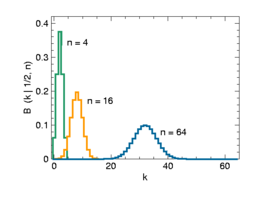
p = 0.5 and n = 4, 16, 64
· 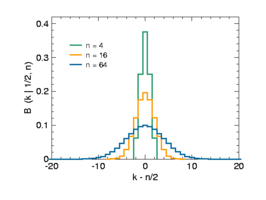
Mean value subtracted
· 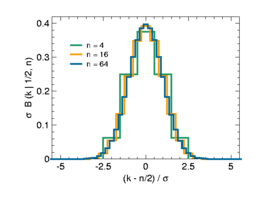
Scaling with standard deviation
This case occurs for the 




This is illustrated in the second figure. The width of the distribution grows in proportion to the standard deviation σ 


Accordingly, binomial distributions with different can be 



The adjacent graph shows rescaled binomial distributions again, now for other values of 


This is the probability density to the standard normal distribution 
The second graph on the right shows the same data in a semi-logarithmic plot. This is recommended if you want to check whether rare events that deviate from the expected value by several standard deviations also follow a binomial or normal distribution.
Pulling balls
There are 80 balls in a container, 16 of which are yellow. A ball is removed 5 times and then put back again. Because of the putting back, the probability of drawing a yellow ball is the same for all removals, namely 16/80 = 1/5. The value 


So in about 5% of the cases you draw exactly 3 yellow balls.
| B(k | 0.2; 5) | |
| k | Probability in % |
| 0 | 0032,768 |
| 1 | 0040,96 |
| 2 | 0020,48 |
| 3 | 0005,12 |
| 4 | 0000,64 |
| 5 | 0000,032 |
| ∑ | 0100 |
| Erw.value | 0001 |
| Variance | 0000.8 |
Number of people with birthday at the weekend
The probability that a person has a birthday on a weekend this year is (for simplicity) 2/7. There are 10 people in a room. The value 

| B(k | 2/7; 10) | |
| k | Probability in % (rounded) |
| 0 | 0003,46 |
| 1 | 0013,83 |
| 2 | 0024,89 |
| 3 | 0026,55 |
| 4 | 0018,59 |
| 5 | 0008,92 |
| 6 | 0002,97 |
| 7 | 0000,6797 |
| 8 | 0000,1020 |
| 9 | 0000,009063 |
| 10 | 0000,0003625 |
| ∑ | 0100 |
| Erw.value | 0002,86 |
| Variance | 0002,04 |
Common birthday in the year
253 people have come together. The value 

| B(k | 1/365; 253) | |
| k | Probability in % (rounded) |
| 0 | 049,95 |
| 1 | 034,72 |
| 2 | 012,02 |
| 3 | 002,76 |
| 4 | 000,47 |
Thus, the probability that "anyone" of these 253 people, i.e., one or more people, has a birthday on that day is 
For 252 persons, the probability is 
The direct calculation of the binomial distribution can be difficult due to the large factorials. An approximation via the Poisson distribution is permissible here ( With the parameter λ 
| P253/365(k) | |
| k | Probability in % (rounded) |
| 0 | 050 |
| 1 | 034,66 |
| 2 | 012,01 |
| 3 | 002,78 |
| 4 | 000,48 |
Confidence interval for a probability
In an opinion poll among 

A solution to the problem without recourse to the normal distribution can be found in the article Confidence Interval for the Success Probability of the Binomial Distribution.
Utilization model
The following formula can be used to calculate the probability that 


Statistical error of class frequency in histograms
The display of independent measurement results in a histogram leads to the grouping of the measured values into classes.
The probability for 




Expected value and variance of 


Thus, the statistical error of the number of entries in class 

When the number of classes is large, becomes 

For example, the statistical accuracy of Monte Carlo simulations can be determined.
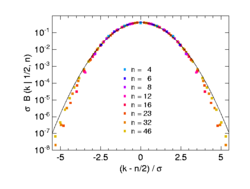
The same data in semi-logarithmic order
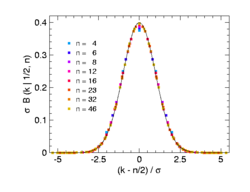
Binomial distributions with p = 0.5 (with shift by -n/2 and scaling) for n = 4, 6, 8, 12, 16, 23, 32, 46
Random numbers
Random numbers for the binomial distribution are usually generated using the inversion method.
Alternatively, one can exploit the fact that the sum of Bernoulli distributed random variables is binomially distributed. To do this, one generates 
Search within the encyclopedia
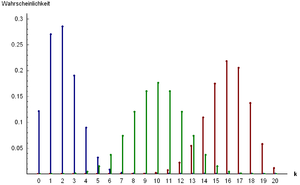




























![{\displaystyle {\begin{aligned}\operatorname {P} (Z=k)&=\sum _{i=0}^{k}\left[{\binom {n_{1}}{i}}p^{i}(1-p)^{n_{1}-i}\right]\left[{\binom {n_{2}}{k-i}}p^{k-i}(1-p)^{n_{2}-k+i}\right]\\&={\binom {n_{1}+n_{2}}{k}}p^{k}(1-p)^{n_{1}+n_{2}-k}\qquad (k=0,1,\dotsc ,n_{1}+n_{2}),\end{aligned}}}](https://www.alegsaonline.com/image/94d620c42183da7a282177dd40b3b98088ed0b2a.svg)












